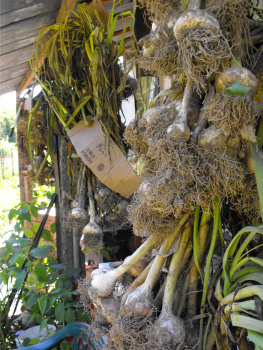
archives for 09/2009
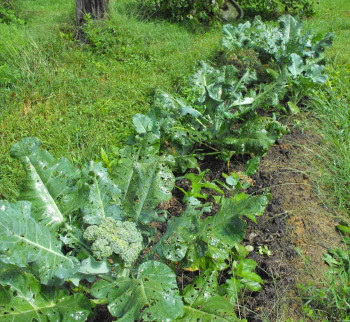 Our oldest broccoli is getting a bit buggy, as
you can see in the foreground. But I'm not worried --- we'll be
eating those heads this week. The broccoli and Egyptian onion
omelet we had for lunch Monday was truly delicious.
Our oldest broccoli is getting a bit buggy, as
you can see in the foreground. But I'm not worried --- we'll be
eating those heads this week. The broccoli and Egyptian onion
omelet we had for lunch Monday was truly delicious.
If you remember, we put in broccoli
seeds as gaps came open in the garden during the height of the
summer. The seeds went in over the course of a month from early
June to early July, and I couldn't have planned it better if I'd
actually put thought into the process. The late-planted broccoli
is a bit stunted, nestled amid the larger early plants. As the
early plants head up, I rip them out, opening up space for the
late-planted broccoli to thrive. I'm hopeful that we'll be eating
broccoli through the end of September, or maybe even later.
Shame-faced plug: Check out the automatic chicken waterer
that funds this blog.
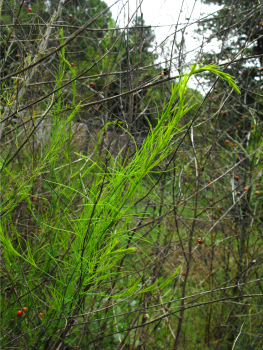 Despite
pretty much beating last year's top farm problems, we still had some
sizeable learning experiences this year. First and foremost, we
discovered that it really is possible to get too much rain. On a
similar vein, grapes
hate wet feet and tomatoes need to be planted as far apart as
possible in the sunniest spot if you're overwhelmed with summer
precipitation.
Despite
pretty much beating last year's top farm problems, we still had some
sizeable learning experiences this year. First and foremost, we
discovered that it really is possible to get too much rain. On a
similar vein, grapes
hate wet feet and tomatoes need to be planted as far apart as
possible in the sunniest spot if you're overwhelmed with summer
precipitation.
We also had a major run-in with asparagus
beetles this year. When I first noticed them this spring, I
thought they were an interesting phenomenon, but by July they had
escalated to the point where the beetle larvae nearly killed all of my
asparagus ferns. My garden guru suggested spraying Bt on
the larvae, and even though the label says that Bt is only effective
against caterpillars, our asparagus has begun to recover. I hate
to advocate spraying (even of a bacterium), but it seems like weekly
spraying of Bt is a very effective method to wipe out asparagus beetle
infestations.
| This post is part of our Third Year of Homesteading lunchtime series.
Read all of the entries: |
Adding a 25 ohm variable resistor gave the Black and Decker battery
powered deer
drill deterrent enough control to be dialed down to an effective
range. It would be easy to recycle an old battery powered drill into
this configuration which could keep the cost well under 20 bucks if
you're lucky.
Stay tuned for a solar powered version in the near future.
| We finally solved the deer in
the garden problem, and the solution was so elegant we gave it a new
website. Check out our deer
deterrent website for free plans! |
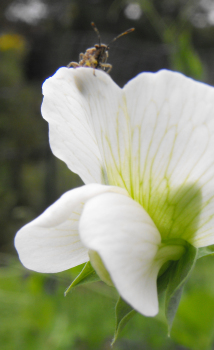 The fall
garden is nearly coming into its own now. This week, I saw
the first pea flowers --- surprisingly, the bush shelling peas opened
first even though they're considerably shorter than both the snow and
sugar snap peas.
The fall
garden is nearly coming into its own now. This week, I saw
the first pea flowers --- surprisingly, the bush shelling peas opened
first even though they're considerably shorter than both the snow and
sugar snap peas.
We have a few tommy-toe tomatoes still coming on, even though their
plants are blighted. For a couple of weeks, we're able to eat the
typical American salad of lettuce, tomato, and cucumbers --- summer and
fall gardens overlapping on our plates. Meanwhile, the week's
freezer bounty includes pesto, swiss chard, broccoli, a tad of
tomatoes, green beans, corn, and okra.
We're actually watering everything this week, since it's been 10 days
since our last serious rain, but the year never really gave us the
usual summer break from weeding and mowing. Instead, Mark and I
are still putting in many hours a week keeping the yard and garden
ship-shape. But I'm starting to put a few beds down for the
winter rather than filling each gap with new seeds. Soon it will
be too late to plant anything except lettuce, spinach, and garlic.
Shame-faced plug: Check out the homemade chicken
waterer
that funds this blog.
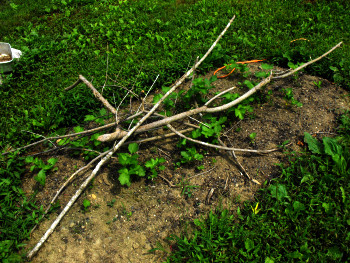 We've learned a lot about
animals this year too. Strider joined our
menagerie and has since become an indispensible purrer. Now
that our pet count has reached three, we've gotten a bit more serious
about bad behavior. Last year, it seemed like Lucy picked a
couple of garden beds and lay on them every day or so, crushing all of
the vegetables there. Huckleberry would also pick favorite beds
and tear up young seedlings in the loose soil.
We've learned a lot about
animals this year too. Strider joined our
menagerie and has since become an indispensible purrer. Now
that our pet count has reached three, we've gotten a bit more serious
about bad behavior. Last year, it seemed like Lucy picked a
couple of garden beds and lay on them every day or so, crushing all of
the vegetables there. Huckleberry would also pick favorite beds
and tear up young seedlings in the loose soil.
This year, we've pretty much nipped that behavior in the bud.
When I see the first signs of pet damage in the garden, I loosely stack
branches on the bed to keep all animals out. The branch technique
seems to be 100% effective, and branches can be safely removed once the
veggies get tall enough to make a scratchy bed.
We've also added two new types of livestock to our farm this year --- earthworms
and honeybees.
We're still learning how to make the best use of them, but I'm thrilled
to learn that both are relatively easy and that honeybees aren't
scary. Probably by this time next year, I'll have something more
to say about bees and worms.
| This post is part of our Third Year of Homesteading lunchtime series.
Read all of the entries: |

We decided to merge the weak hive with a stronger one today using the
newspaper trick. You place a layer of newspaper between the two hives
and cut a few slits here and there. It takes the bees a few days to eat
through the paper...giving them time to acclimate to a new frequency of
the same hive mentality.
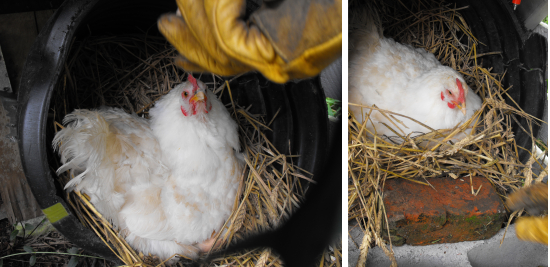
Our Cochin has been almost too good of a mother --- for days at a time, it looked
like she hadn't moved an inch. Only lowered
water levels in her Avian Aqua
Miser reassured me that she wasn't going to die of thirst.
(Yes, I am a worrywort.)
Then the worst
happened. One morning I peeked in her brood coop and noticed five
eggs lying on the ground! Our brood hen had worked her way to the
edge of the drainage tile and a full third of her eggs had slipped off
the nest.
Mark risked his life by tossing all five gently over the hen's back,
hoping that they hadn't been away from her warmth for too long.
The he stacked a cinderblock and brick in front of the culvert as a
temporary lip.
If everything
goes according to plan, we should see the our farm's first homegrown
chicks sometime tomorrow or Saturday. Whether we'll have thirteen
chicks or just a few, though, is still up in the air.
Read all of the entries about
our broody hen:
|

As long as I can
remember, I've hopped from obsession to obsession --- Robin Hood, water
gardening, identifying native plants. This year's obsessions are permaculture
and forest
gardening, topics that will probably take me decades to truly mull
over. In the last year, we have started two forest
gardens around young fruit trees in the yard and a
more traditional forest garden in existing young woods, all of
which are in early stages.
One of the biggest things I've learned about permaculture is that comfrey is
unstoppable. We started off the year with one large, two-year old
plant. All summer, I hacked off pieces and spread them around our
new forest gardens. Now we have dozens of thriving comfrey plants
that don't seem to mind being mown to the ground once a week.
I'm also starting to feel the homestead turn into a closed food
web. Mulching
with grass clippings
has turned our grassy areas into working elements of the forest
garden. Nitrogen flows from chickens to grass to my garden beds,
and I
get pure joy out of seeing my plants thrive. Meanwhile, our
honeybees pollinate garden plants and will eventually feed us
honey. Around and around the permaculture wheel rolls.
| This post is part of our Third Year of Homesteading lunchtime series.
Read all of the entries: |
 I used up our last extension cord last
week when I installed the first Black and Decker deer
drill deterrent which meant I had to unplug units 1 and 5 to get my
share of electricity for a drill press project I was doing this
afternoon.
I used up our last extension cord last
week when I installed the first Black and Decker deer
drill deterrent which meant I had to unplug units 1 and 5 to get my
share of electricity for a drill press project I was doing this
afternoon.
Well....I got busy doing something else and forgot to plug deer
deterrents 1 and 5 back up....so that makes about 45 minutes of down
time. I looked out our living room window in shock to see the ugliest
deer I've ever seen munching down on a few sweet potato leaves like it's
nobody's business!.....I quickly ran out the door and chased after the
four legged monster to show it who's boss around here.
Now I know the local deer population is so bad I can't take a
brief pause even during a sunny day from the new mechanical deer drill deterrents without being
munched on.
| We finally solved the deer in
the garden problem, and the solution was so elegant we gave it a new
website. Check out our deer
deterrent website for free plans! |
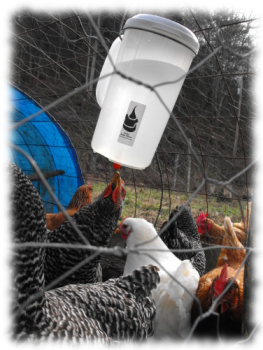 Every
week, Mark and I mail off dozens of chicken waterers. They seem
to disappear into the void, since we seldom hear back from any of our
customers. We especially miss not getting to see how our waterers
fit into other folks' lives.
Every
week, Mark and I mail off dozens of chicken waterers. They seem
to disappear into the void, since we seldom hear back from any of our
customers. We especially miss not getting to see how our waterers
fit into other folks' lives.
In hopes of dredging some photos out of that void, we're holding a
photo contest over on our automatic
chicken waterer
site. If you bought one of our waterers, or just made our own
waterer, we hope you'll wander over there and email us your
photos. To sweeten the pot, we're giving away three ready to go
waterers to one grand prize winner. Good luck!

Perhaps our largest
learning experience this year has been our microbusiness. At this
time last year, I was just starting to burn out on my job, but I was
terrified to quit. Everyone was talking about the economy tanking
and I knew that jobs in our area were scarce.
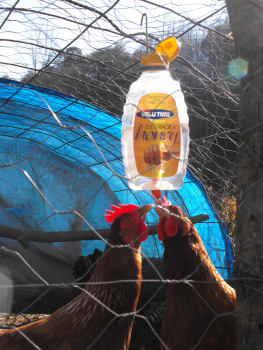 But I did it anyway, and together Mark and
I started marketing his automatic
chicken waterer. It took a few months for us to get our feet
under us, but before long we were making more money and working fewer
hours. We had shed 85% of the stress associated with my old job,
and we both felt immensely empowered by the experience. Why did
we ever want to work for someone else?
But I did it anyway, and together Mark and
I started marketing his automatic
chicken waterer. It took a few months for us to get our feet
under us, but before long we were making more money and working fewer
hours. We had shed 85% of the stress associated with my old job,
and we both felt immensely empowered by the experience. Why did
we ever want to work for someone else?
We have a lot of projects in the hopper for the next year, of
course. As I mentioned a couple of days ago, we want to share all
of our deer deterrent secrets with the world --- we figure we owe the
community something totally free. Next on the agenda is finishing
up the ebook we've been drafting to help other folks mimic our
microbusiness success.
We don't plan to expand our gardening perimeter over the next year,
just to keep bringing it closer to a state of equilibrium. I want
to keep exploring permaculture, and Mark has several new inventions on
the drawing board (automatic bug feeder for your chickens, anyone?)
Most all, though, we want to keep feeling the power of the Walden
Effect. I hope you can all catch a whiff of the fragrance through
your monitors. Just as this year was better than last year, I
suspect next year will be the best one yet!
| This post is part of our Third Year of Homesteading lunchtime series.
Read all of the entries: |

One manure lesson we learned this year was the 5 gallon bucket method.
It makes the portions easy to handle and load into the back of the
minivan. The haul in this picture is a typical amount we get in trade
for a dozen fresh eggs from some friendly neighbors down the road.
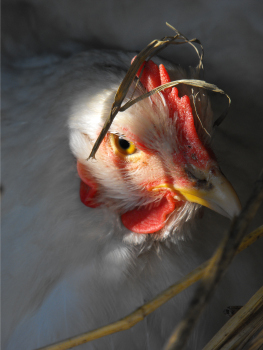 Friday afternoon, I stopped by to check on our
broody hen.
At first, I thought she was turning her eggs --- she was raised off
the nest a little bit, and her beak was underneath her belly.
Then I saw that one egg seemed to have a small hole in it. I
leaned closer....
Friday afternoon, I stopped by to check on our
broody hen.
At first, I thought she was turning her eggs --- she was raised off
the nest a little bit, and her beak was underneath her belly.
Then I saw that one egg seemed to have a small hole in it. I
leaned closer....
"Grawwk!!" Rather than losing a finger, I backed off and the
mother hen settled back into place. I started to leave, then
heard the first tiny "peep" from underneath her.
I sat by the coop for about an hour, hoping to catch a shot for you all
to see (or at least a glimpse for myself.) But despite hearing
several peeps, and what seemed to be the sound of a tiny chick pecking
its way out of its shell, I never got a glimpse of a chick.
Do we have one homegrown chick or a dozen? Maybe I'll know by the
end of the day. Meanwhile, I'll leave you with this photo of the
mother hen, a piece of straw stuck to her comb. She may look cute
and fluffy, but I won't be petting her anytime soon.
Read all of the entries about
our broody hen:
|
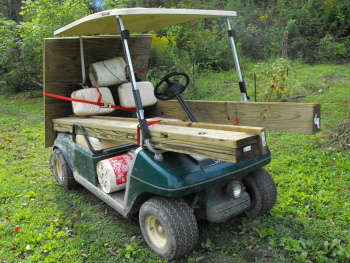 I've had a few of those small ratchet straps
for a couple of years now and they really come in handy...but they also
have a problem getting hung up and stuck in some pretty nasty tangles
if the load shifts.
I've had a few of those small ratchet straps
for a couple of years now and they really come in handy...but they also
have a problem getting hung up and stuck in some pretty nasty tangles
if the load shifts.
We got a set of the medium sized ones a few weeks ago and I'm still
kicking myself for wasting so much time on the small version. No more
pinched fingers and frayed straps with the bigger more substantial
mechanism.
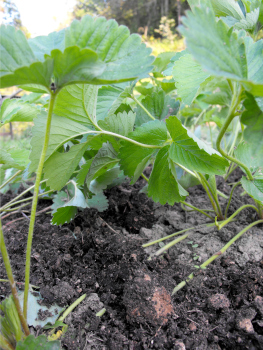 Without
deer to nibble them back, our strawberry beds have turned into a sea of
three-part leaves. While the beds look lush and beautiful, the
farmer inside me knows that the plants are overcrowded and won't bear
well next year. Time to take drastic action.
Without
deer to nibble them back, our strawberry beds have turned into a sea of
three-part leaves. While the beds look lush and beautiful, the
farmer inside me knows that the plants are overcrowded and won't bear
well next year. Time to take drastic action.
Many gardeners mow their strawberry beds to the ground in early summer
as soon as they pick the last berries. Their goal is to stimulate
the production of runners so that new plants will form. My
strawberries didn't get this treatment, nor did they seem to need it
--- runners formed every which way, growing across the aisles to the
next bed over.
Instead of mowing, I finally bit the bullet and ripped out three
quarters of the plants, giving the remaining strawberries room to
breathe. I tucked well-rotted manure around their roots, and plan
to add a nice load of grass clippings after our next mowing.
Although it would have been smarter to renovate my beds in June, I'm
hopeful that there's still enough growing time left for the plants to
suck up summer sun and prepare for spring berries. Hopefully next
year, we won't be disappointed by micronutrient
deficient berries the way we were this spring.
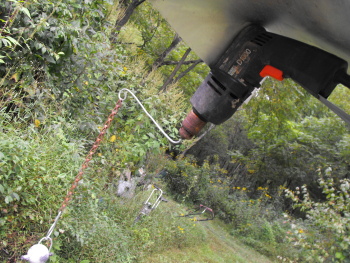 A variable speed drill with a conventional
cord turns out to be a good and cheap option for the locomotion of our mechanical deer deterrent
contraption.
A variable speed drill with a conventional
cord turns out to be a good and cheap option for the locomotion of our mechanical deer deterrent
contraption.
A quick search of E-bay shows that several can be had in the 10 dollar
range, and new ones go for a bit over 20 at the big box stores.
I wonder if a lamp dimmer switch would be strong enough to provide a
variable speed option for drills that only have on and off and nothing
in between?
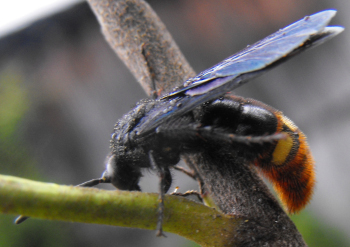 These wasps have been flying low over the
garden for a couple of weeks now, but I only got a closer look on
Sunday morning. Five had settled down on a young apple tree, and
the cool, dewy morning kept them in place even when I stuck the camera
in their faces.
These wasps have been flying low over the
garden for a couple of weeks now, but I only got a closer look on
Sunday morning. Five had settled down on a young apple tree, and
the cool, dewy morning kept them in place even when I stuck the camera
in their faces.
I'd assumed the insects were adult squash vine borers, but I wasn't
even in the right ballpark; instead of being garden pests, these wasps
are our new best friends. Digger Wasps (Scolia dubia) are the primary
natural enemy of both Japanese
Beetles and June Bugs. The female wasps burrow into the soil
in search of beetle grubs, paralyze the immature beetles with their
stingers, then lay an egg on each paralyzed grub. The grub serves
as a comatose but living buffet for the baby wasp, who eats the grub
beyond repair. Now I just need to figure out how to further
encourage our Digger Wasp population and knock out the Japanese Beetles
once and for all!
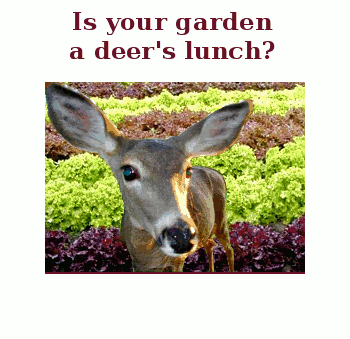 Autumn is peak deer damage season in
gardens across the U.S. Your neighborhood doe probably had a
couple of fawns this spring, and those three mouths are hungry.
Autumn is peak deer damage season in
gardens across the U.S. Your neighborhood doe probably had a
couple of fawns this spring, and those three mouths are hungry.
I've fought deer in the garden for nearly a decade now, and I have to
admit that until this year they've won every battle. Give the
deer half a chance and they'll wipe out your garden in short
order. Last year, they ate our strawberries and sweet potatoes,
then moved on to swiss chard, and ate onions for dessert. We
barely had anything fresh from early autumn on.
But as our regular readers know, Mark saved the day with a homemade
deer deterrent that really works. He's been working on making a
version that everyone can copy out of cheap supplies, and I've been
working on a deer repellant
website to go along with it.
This week's lunchtime series skims over the highlights of what we've
learned, but feel free to head over to the other website for more
information.
| This post is part of our Homemade Deer Deterrent lunchtime series.
Read all of the entries: |
Our number 5 deer deterrent got hung up today due to some cracks in the
metal flashing. No doubt the increased banging was the cause. I
replaced it with some thicker metal salvaged from a junk pile. I then
moved some longer flashing towards the back for it to absorb the second
hit, which provides a unique vibration and some added motion for any
potential 4 legged garden poachers out there who have yet to get the
message that our vegetables are off limits.
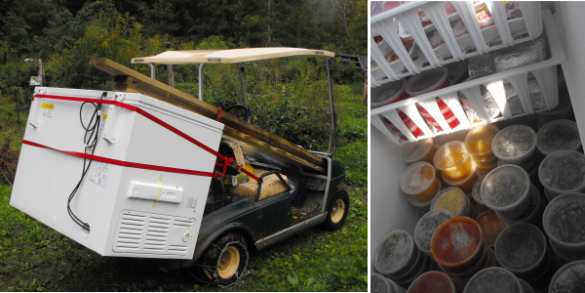
You
may have noticed that our website has received a face lift.
Hopefully now it will show up properly for all of you Internet Explorer
users. Stay tuned for other upgrades as we celebrate our first
year on the internet!
Meanwhile, Mark and I splurged and got a brand new, Energy Star
freezer. We'd filled our small freezer to the gills over the last
few weeks, but I didn't want to plug in the big freezer because of its
leaky gasket.
The new freezer has handy sliding baskets and lots
of room to put away more produce, and its annual energy usage is on a
par with our little fridge. Can you believe that Mark
attached it to the golf cart and hauled it back to our trailer all by
himself?
Finally, the bad news. I've waited to post about this until now,
because I didn't want to think about it. Remember how I said that
our broody hen
was poking
around under her belly when I heard the peeping Friday
evening? It seems that she was killing the chick, not helping it
out of its shell. She continued to pummel the dead chick with her
bill Saturday morning until I scooped it out of the nest, and now the
hen is happily sitting on top of what may be more dead chicks for all I
know. No more peeping. I have no idea what we're going to
do with this hen who is so obsessed with brooding that she kills her
offspring when they get in the way. (Well, the stew pot
beckons....)
 Mark's homemade deer deterrent is based on a cheap
drill you can get at Wal-Mart for $10.48. He used a transformer
to switch the drill from battery power to AC electricity, then wired in
a potentiometer to allow him to speed up and slow down the drill.
Mark's homemade deer deterrent is based on a cheap
drill you can get at Wal-Mart for $10.48. He used a transformer
to switch the drill from battery power to AC electricity, then wired in
a potentiometer to allow him to speed up and slow down the drill.
The drill bit has been modified to attach to a wire, chain, and golf
ball. The golf ball swings around, hitting a piece of tin and
making a metallic noise. The combination of man-made noise and
motion has been 100% effective in keeping deer out of our garden this
summer, and has even kept them away from our perimeter.
Check out our step by step instructions to make your own deer
deterrent for $30 (or much less if you scavenge supplies.) In
case you're curious, I did the math on operating costs too --- each
deterrent costs a little over $3 to run per year. Definitely
within my skinflint price range.
| This post is part of our Homemade Deer Deterrent lunchtime series.
Read all of the entries: |
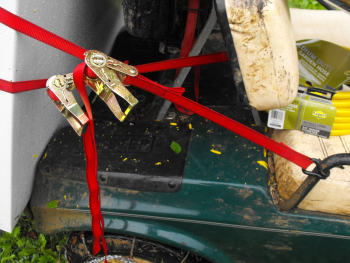 Having 2 medium ratchet
straps made it possible to hold the freezer in place while I used
the other strap to finalize the mount.
Having 2 medium ratchet
straps made it possible to hold the freezer in place while I used
the other strap to finalize the mount.
Speaking of freezers, We saw a fresh independent film last month by the
name of Freezer
Burn. The hero is a quirky scientist who sells his house in order
to raise enough money to modify a freezer so that he can be frozen for
15 years in an effort to capture the attention of a girl he has a thing
for. It's that good kind of whacky that makes you feel just a little
bit more alive after viewing it. I give it 2 thumbs up for its charm
and wit.
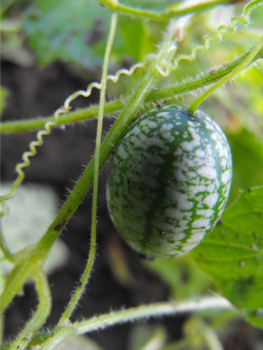 One of the new vegetable varieties we're
trying out this year is the Mexican Sour Gherkin (Melothria scabria). It's
billed as a tiny cucumber that is resistant to the wilts that tend to
kill normal cucumbers on our farm, and I can attest to the species
being much less disease-ridden.
One of the new vegetable varieties we're
trying out this year is the Mexican Sour Gherkin (Melothria scabria). It's
billed as a tiny cucumber that is resistant to the wilts that tend to
kill normal cucumbers on our farm, and I can attest to the species
being much less disease-ridden.
On the other hand, I don't think they really taste like cucumbers ---
the gherkins are more sour and lack that cucumber tang. Another
disadvantage is that Mexican Sour Gherkins get off to a slow
start...but maybe that's an advantage since in our garden they started
bearing at about the same time our cucumbers gave up the ghost.
Mexican Sour Gherkins are certainly cute, and they are tasty even if they don't really
taste like cucumbers. It's also pretty cool to be growing a
vegetable variety which seems to have been cultivated unchanged since
before Europeans showed up in North America. While they're not a
new superhero of the garden, I think we'll keep growing gherkins.
 The trick to keeping deer out of the
garden with our deer deterrent
is understanding deer behavior. Deer follow the same paths day
after day from one known food source to another. Chances are that
if your garden has been nibbled, deer have one to several well worn
paths through the perimeter. A deer deterrent should go smack dab
in the middle of each path.
The trick to keeping deer out of the
garden with our deer deterrent
is understanding deer behavior. Deer follow the same paths day
after day from one known food source to another. Chances are that
if your garden has been nibbled, deer have one to several well worn
paths through the perimeter. A deer deterrent should go smack dab
in the middle of each path.
Finding deer paths is pretty easy. Head out after a rain to look
for the heart-shaped hoof prints in soft soil, and follow them backward
to where they breached your garden. If the ground is too hard for
tracking, keep an eye out for freshly nibbled leaves and use those to
track the deer's path through the garden.
If your garden is large, the deer may try to bypass the first deterrent
and make a new path. That's why I recommend that you keep a close
eye on your garden for the first couple of weeks after you put your
deterrent(s) up. If you see a new path forming, immediately build
a new deer deterrent. It's much easier to keep deer out of the
garden before they consider it their main food source. As you can
see in the aerial photo above, it doesn't take many deterrents to
protect even a large space --- we have six devices to cover about two
acres.
| This post is part of our Homemade Deer Deterrent lunchtime series.
Read all of the entries: |

I was describing my new home
made frame perch tool design to a friend and he furrowed his brow
when I mentioned how I used wood instead of metal. He was concerned
about a full frame of honey being too much weight for such a "light
duty" structure.
That possible problem was fixed easily with the next size down L
bracket being secured in each corner. You might need to chisel out a
groove for the bracket depending on how much wiggle room your frames
have to move back and forth while still staying snug.
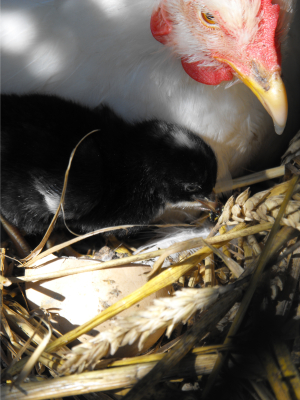 We never did anything about our murderous
hen because I didn't want to think about it, and there's always
plenty of other stuff on the farm to catch our attention. Then,
on Wednesday afternoon, I heard peeping from her coop again. I
wandered over and...chick! Living chick! Hatched and dried
and playing nice with Mama!
We never did anything about our murderous
hen because I didn't want to think about it, and there's always
plenty of other stuff on the farm to catch our attention. Then,
on Wednesday afternoon, I heard peeping from her coop again. I
wandered over and...chick! Living chick! Hatched and dried
and playing nice with Mama!
So, I'm revising history. Perhaps that first dead chick wasn't
quite strong enough to make it out of its shell, as sometimes
happens. Maybe Mama tried to help, but the chick died anyway, and
the extra pecking was just pecking at a dead thing in her nest.
Maybe Wednesday's chick didn't hatch on day 21 as it should have
because of temperature inconsistencies. We got our eggs from a
friend who had been storing them at room temperature for a couple of
days. Maybe it took the eggs a few days after getting under our
broody hen to warm back up to incubation temperatures. Maybe even
more chicks are due?
One of Mark's favorite phrases in relation to me is "ye of little
faith." And...I guess he's right!
 When I talk to locals about
the deer overpopulation problem, their inevitable response is "why
don't you get a gun?" The problem with hunting as a solution to
deer in the garden is that it's illegal to kill a deer out of season,
even on your own property, unless you get a special permit from the
game warden. Hunting during the normal season does keep deer out
of your garden...for about a week.
When I talk to locals about
the deer overpopulation problem, their inevitable response is "why
don't you get a gun?" The problem with hunting as a solution to
deer in the garden is that it's illegal to kill a deer out of season,
even on your own property, unless you get a special permit from the
game warden. Hunting during the normal season does keep deer out
of your garden...for about a week.
That said, I'm convinced that hunting is the long term solution to our
deer overpopulation problem, but only if our game laws are
changed. Currently, most game management agencies are actively
working to promote deer population growth, a throwback to a few decades
ago when deer were scarce. If laws are changed to allow hunters
to kill more does, we might be able to get our deer populations back
under control.
| This post is part of our Homemade Deer Deterrent lunchtime series.
Read all of the entries: |
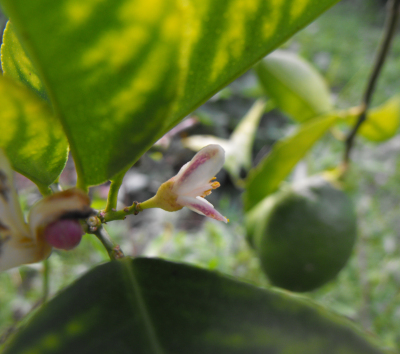 Our movie star neighbor has an absolutely
stunning Dwarf Meyer Lemon that he brings inside for the
winter. Last year, he got 91 delicious lemons from a tree no more
than three feet tall (though more like six feet wide.)
Our movie star neighbor has an absolutely
stunning Dwarf Meyer Lemon that he brings inside for the
winter. Last year, he got 91 delicious lemons from a tree no more
than three feet tall (though more like six feet wide.)
Mark's mom heard us enthusing over our neighbor's tree, and Christmas
2007 a baby lemon tree was waiting for us at her house. We put
our tree in a five gallon pot, showered the lemon with love, compost
tea, and vermicompost, and ate
our first four lemons at this time last year.
This year, there are two big fruits starting to ripen, seven baby
lemons no more than a couple of inches in diameter, and another passel
of blooms just opening. But as you can see in the photo above,
the older leaves are starting to look chlorotic (turning yellow between
the veins), denoting a nutrient deficiency. Our movie star
neighbor fertilizes his tree regularly with Miracle Grow, but we're
trying to go the organic route. This spring, we topdressed with a
gallon or two of compost, which prompted scads of blooms, but our lemon
has clearly worked her way through all of the nutrients. I fed
her again this week, this time with a gallon of composted horse manure,
and am hoping that the recent rain has washed enough nutrients over her
roots to keep her producing.
Mark dreams of some day having two mature dwarf lemon trees, which we
figure would be just about enough to keep us in lemons all year.
I'm hoping our dwarf tangerine (a year younger than our lemon) will
join the mix and keep us citrified. Citrus is often one of the
hardest things for locavores to give up, and we'd like to avoid that
sacrifice.
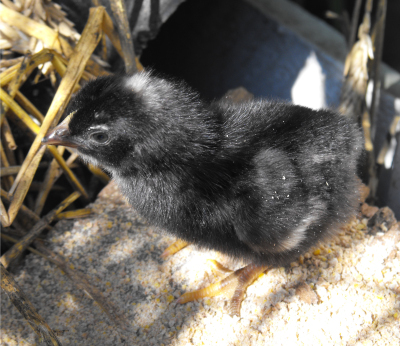 Due to the new
trend of backyard chicken-keepers, figuring out the sex of chicks
at birth has turned into big business. Most people with a small
flock
of chickens can only handle one rooster or they'll end up in a lot of
cock fights, while other people want only male birds since males put on
weight faster and thus make better broilers. If you check out the major
online hatcheries, you'll see that you can buy all male chicks, all
female chicks, or a straight run (mix of both.)
Due to the new
trend of backyard chicken-keepers, figuring out the sex of chicks
at birth has turned into big business. Most people with a small
flock
of chickens can only handle one rooster or they'll end up in a lot of
cock fights, while other people want only male birds since males put on
weight faster and thus make better broilers. If you check out the major
online hatcheries, you'll see that you can buy all male chicks, all
female chicks, or a straight run (mix of both.)
The eggs I was given are from two breeds that are easy to sex at
birth. I believe all of the eggs have Dominique fathers while
some have Dominique mothers and some have Black Sex-Link mothers.
In Dominickers (as Dominiques are fondly called), yellow
feet and a diffused white spot on the head mark males, while grayer
feet and a compact white spot mark females. Black
Sex-Links are even easier to tell apart (that being the whole point
of the hybrid breed), with males but not females showing a white spot
on their heads.
Chances are that Wednesday's chick is a male, due to its yellow feet
and white spot. That means we won't get too attached and will instead
start calling him "Thanksgiving Dinner."
 Although our deer
deterrents work like a charm, Mark's got a lot of other related
ideas in the pipeline. We enjoy the sound of our deterrents ---
they're on a par with the crickets at night --- but I suspect they
wouldn't go over well in suburbia. We're also intrigued by the
idea of running a deer deterrent on some kind of cheap solar panel, and
finding a way to make them even cheaper for folks to build.
Although our deer
deterrents work like a charm, Mark's got a lot of other related
ideas in the pipeline. We enjoy the sound of our deterrents ---
they're on a par with the crickets at night --- but I suspect they
wouldn't go over well in suburbia. We're also intrigued by the
idea of running a deer deterrent on some kind of cheap solar panel, and
finding a way to make them even cheaper for folks to build.
We're testing out a Creative Commons open source system for our deer
deterrent, giving away the information for free, but asking folks to
credit us if they use it. We're hoping that adding several
hundred inventors to the mix will result in an even better deer
deterrent by this time next year. So, feel free to tell all of
your friends about the plans, and get them to send us their innovations
and pictures! If you're interested in hearing about those
innovations, subscribe to our deer deterrent blog
--- we won't be posting all of the nitpicky details here. And
good luck with keeping the ravenous deer out of your garden!
| This post is part of our Homemade Deer Deterrent lunchtime series.
Read all of the entries: |
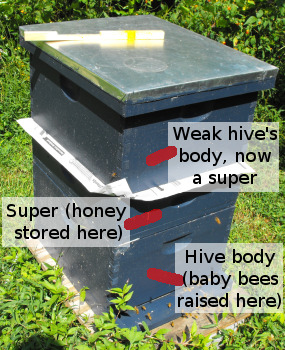 Soon after we united our
two weakest hives, the weather turned cool and wet --- bad
bee-checking conditions. Finally, I got impatient and went out to
inspect the bees between showers.
Soon after we united our
two weakest hives, the weather turned cool and wet --- bad
bee-checking conditions. Finally, I got impatient and went out to
inspect the bees between showers.
Outside the hive, a fringe of newspaper was clearly evident between the
merged hive sections, so I figured I'd need to remove the paper
divider. But when I took off the super from the weak hive, I saw
that the industrious bees had carefully eaten away the entire newspaper
up to the wooden hive walls!
The hive merge is complete and very successful. While our other
two, formerly strongest hives are still filling up their first super
apiece, our newly merged hive is starting to store honey between
hatching brood in the big top super! I can only assume this means
that the queen from the weak hive has been assassinated and her workers
assimilated into the population. Although I probably wouldn't
repeat my frame
swap experiment, the hive merge is going to be added to my toolkit.

Note: Mark hasn't been posting
because he's a bit under the weather. I expect him to be back
online in short order, but until then you'll just have to put up with
me. If you miss his ingenuity, go visit his homemade chicken
waterer site and his homemade
deer deterrent site. There, don't you feel better?
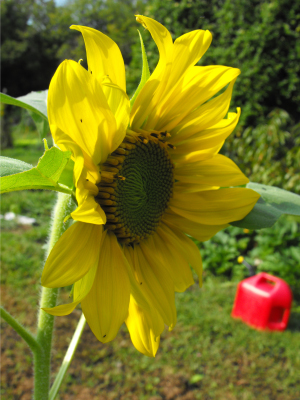 Thursday night, our new chick (nicknamed
Thanksgiving Dinner), squeezed out of the brood coop through a tiny
hole. His mother couldn't follow him, and apparently he wasn't
bright enough to squeeze back in.
Thursday night, our new chick (nicknamed
Thanksgiving Dinner), squeezed out of the brood coop through a tiny
hole. His mother couldn't follow him, and apparently he wasn't
bright enough to squeeze back in.
Temperatures dropped to the low fifties. When I found
Thanksgiving Dinner the next morning, he was cold and peeping
desperately. I popped him back into the brood coop, but Mama Hen
no longer seemed interested in him despite his obvious need for warmth.
The next best bet, I figured, was to rig up a light over a box to warm
him the way you do with motherless chicks. The problem is that
we've
completely converted over to compact fluorescents and don't have a
single incandescent bulb left in the house! I dashed to town, but
by the time I got home an hour later, Thanksgiving Dinner had given up
the ghost.
I honestly can't blame this second chick death on Mama Hen. It's
entirely my fault for not chick-proofing the walls of the brood coop
better (and for not keeping an incandescent bulb on hand for
emergencies.) I feel awfully guilty (strange since I was going to
eat him in a few months anyway!), but have resolved to try again in the
spring. I suspect our second attempt will be a lot more
successful --- surely we've done everything wrong that we possibly
could on this first attempt!
Anna and I finally got a chance to watch a film my cousin was in a
couple of years back and I couldn't resist the urge to swipe the scene
under the fair use doctrine. He's the one sleeping on a bench. I slowed
down the video to half speed so you won't miss him.
The film was directed by Fred Durst and it's a period piece set in the
early 1970's titled "The Education of Charlie Banks". It was a good
coming of age story that unfolded nicely and captured our attention.
Great job Ben, can't wait to see what you star in next.
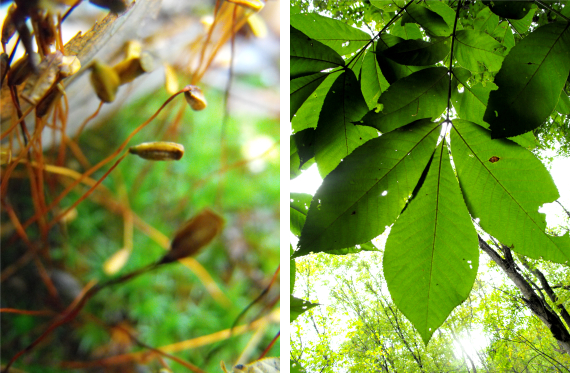
Summer and fall are starting
to intertwine in the woods, just like they are in the garden. Our
"unused" 56 acres really pull their weight, providing us with unlimited
natural beauty and a great buffer from our neighbors.
That said, a few neighbors made the half mile trek back to our trailer
Saturday afternoon, beers in hand. One suggested that we could
sell the siding from our hundred year old barn for $17 per board
foot. This price seems phenomenal to me --- could it have been
the beer speaking? Surely our barn isn't worth tens of thousands
of dollars?
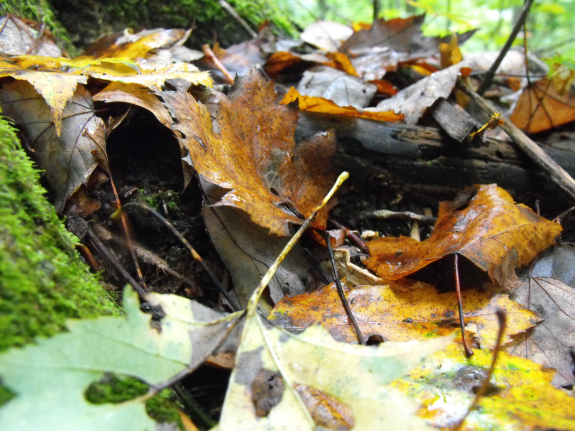
 Like Anna said this morning, we had a few
visitors drop by yesterday, and I still can't get over what they were
thinking as they made the hike back here.
Like Anna said this morning, we had a few
visitors drop by yesterday, and I still can't get over what they were
thinking as they made the hike back here. I've been watching our
I've been watching our 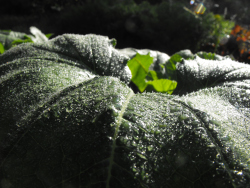
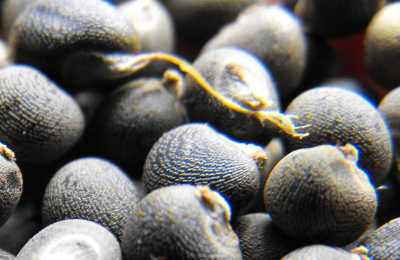 Many homesteaders save seeds because they
don't trust the big companies to keep producing varieties they care
about. Skinflints like me save seeds because seed prices have
been skyrocketing in the last couple of years. Whatever your
reasoning, saving seeds can be pretty painless if you understand a bit
of plant biology.
Many homesteaders save seeds because they
don't trust the big companies to keep producing varieties they care
about. Skinflints like me save seeds because seed prices have
been skyrocketing in the last couple of years. Whatever your
reasoning, saving seeds can be pretty painless if you understand a bit
of plant biology.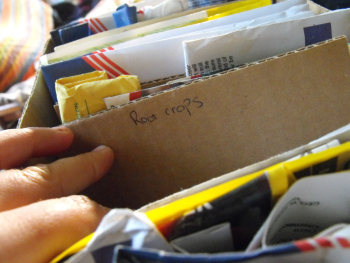 The rest of this week's lunchtime series will
explain how to save seeds from some easy vegetable varieties. But
before you go, a couple more words of wisdom. First of all, you
won't need to save seeds every single year ---
The rest of this week's lunchtime series will
explain how to save seeds from some easy vegetable varieties. But
before you go, a couple more words of wisdom. First of all, you
won't need to save seeds every single year --- 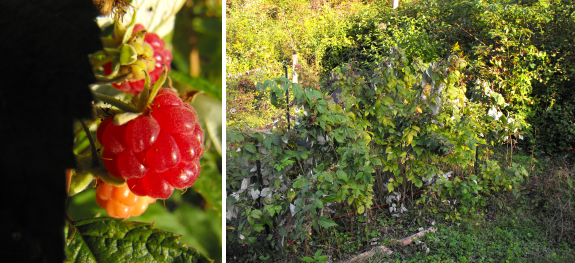
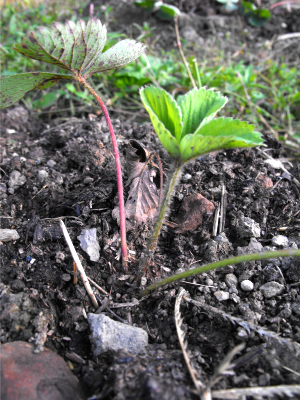 We were disappointed with the flavor and size
of our strawberries this spring, so we're working to remedy the
situation. A week or so ago, we
We were disappointed with the flavor and size
of our strawberries this spring, so we're working to remedy the
situation. A week or so ago, we  One of the biggest risks when saving seeds in
a diverse garden is unintentional hybridization. Say you're
growing two varieties of okra relatively close together, the way we did
last year. If you try to
One of the biggest risks when saving seeds in
a diverse garden is unintentional hybridization. Say you're
growing two varieties of okra relatively close together, the way we did
last year. If you try to 
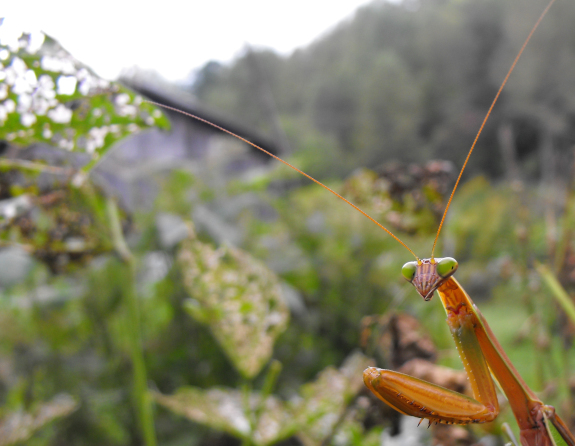
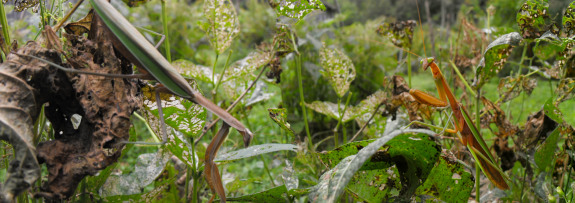
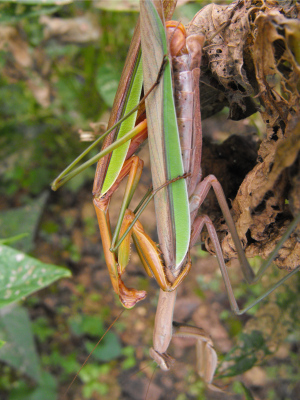
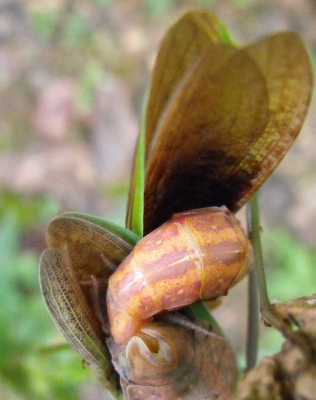
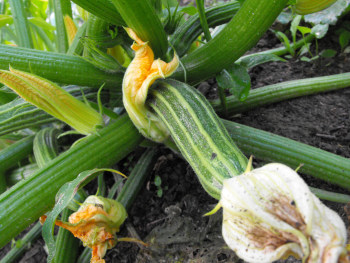 Cucurbits (squashes, pumpkins, cucumbers, and
melons) are a bit more difficult seed-saving candidates than peas and
beans because cucurbits hybridize readily. If you're careful,
though, they can be on your easy seed-saving list.
Cucurbits (squashes, pumpkins, cucumbers, and
melons) are a bit more difficult seed-saving candidates than peas and
beans because cucurbits hybridize readily. If you're careful,
though, they can be on your easy seed-saving list.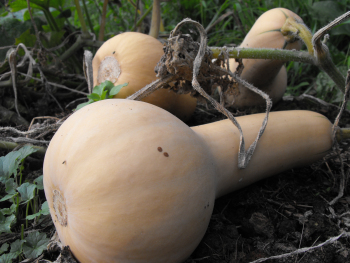 Some species are simple --- cucumbers are all
in the same species (
Some species are simple --- cucumbers are all
in the same species (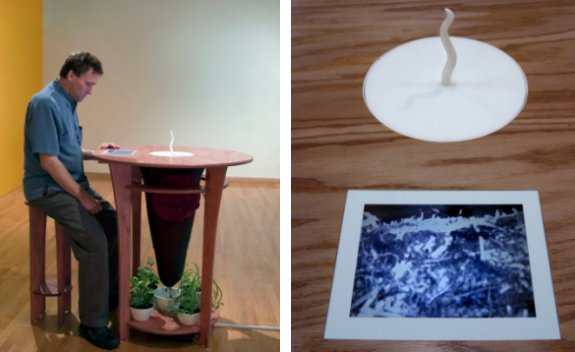
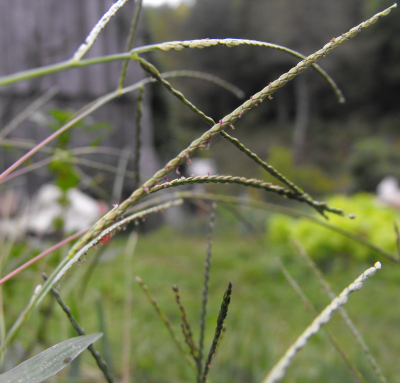 If Mark and I seem a bit flaky this week, it's
because we're planning a big party for four or five dozen of our
closest friends and relatives on Saturday. We figured we owed
them a get-together for
If Mark and I seem a bit flaky this week, it's
because we're planning a big party for four or five dozen of our
closest friends and relatives on Saturday. We figured we owed
them a get-together for 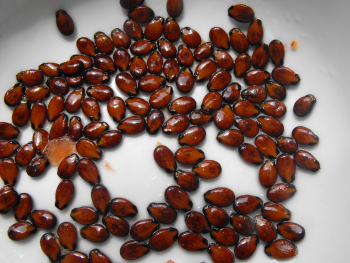
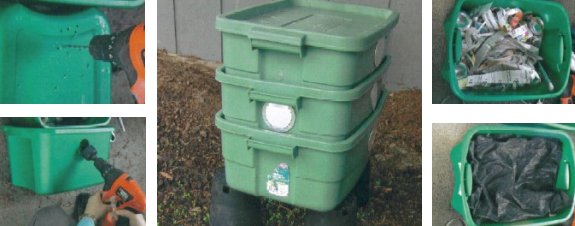
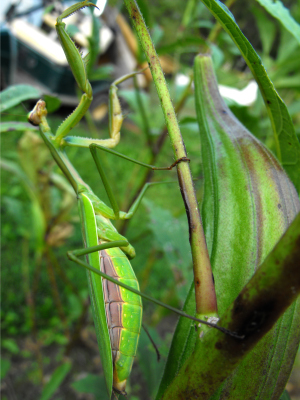 This seems to have been a very good year for
praying mantids in our garden. I stumbled across this green-eyed
male as I picked okra for our supper on Thursday. Can you believe
how full his belly is?
This seems to have been a very good year for
praying mantids in our garden. I stumbled across this green-eyed
male as I picked okra for our supper on Thursday. Can you believe
how full his belly is? The last of the easy seeds we save are
tomatoes and peppers. I've combined them into this post even
though they have different seed-saving techniques since they're in the
same family. If you've been reading along daily, these guys are
just a repeat of the methods we've been discussing all week.
The last of the easy seeds we save are
tomatoes and peppers. I've combined them into this post even
though they have different seed-saving techniques since they're in the
same family. If you've been reading along daily, these guys are
just a repeat of the methods we've been discussing all week.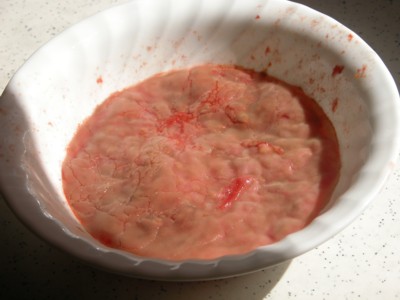
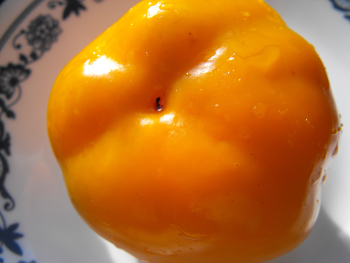 We like our peppers red or yellow and sweet,
but I'm not usually willing to put in the time to start them indoors in
early spring. They seem to be more tender than tomatoes, and
unable to be started in a cold frame. That means I direct sow
peppers right around our spring frost free date, and hope some will
have time to ripen all the way before the first fall frost. Last
year, we didn't have much luck ---
We like our peppers red or yellow and sweet,
but I'm not usually willing to put in the time to start them indoors in
early spring. They seem to be more tender than tomatoes, and
unable to be started in a cold frame. That means I direct sow
peppers right around our spring frost free date, and hope some will
have time to ripen all the way before the first fall frost. Last
year, we didn't have much luck --- 
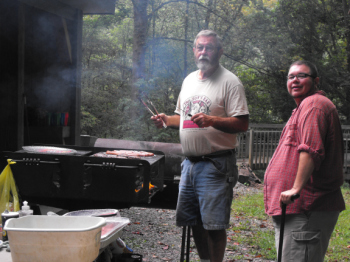 Now
that it's over, I think I understand the point of a wedding. It's
the one time in your life when you can count on the people you care
about to show up together and at least look each other in the eye ---
the bare minimum for community formation. Mark's uncle and my dad
talked about tinkers, my college buddy and my brother talked about
Debian, and every sibling I own came together under one picnic shelter
for a few hours.
Now
that it's over, I think I understand the point of a wedding. It's
the one time in your life when you can count on the people you care
about to show up together and at least look each other in the eye ---
the bare minimum for community formation. Mark's uncle and my dad
talked about tinkers, my college buddy and my brother talked about
Debian, and every sibling I own came together under one picnic shelter
for a few hours. Although
to many women, their wedding is their "big day," I now realize that in
a proper world the ceremony is not really about the bride and
groom. It's about forming connections between two circles of
family and friends, hoping that maybe something will stick. After
a week of angst and tearing out my hair, it's pretty funny that I
finally figured out the point of our wedding after the fact!
Although
to many women, their wedding is their "big day," I now realize that in
a proper world the ceremony is not really about the bride and
groom. It's about forming connections between two circles of
family and friends, hoping that maybe something will stick. After
a week of angst and tearing out my hair, it's pretty funny that I
finally figured out the point of our wedding after the fact!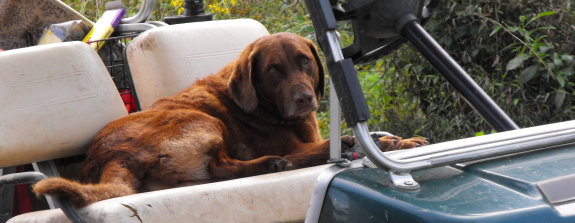
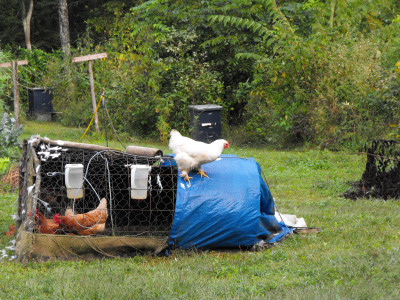 Our White Cochin started her broodiness early
this spring, and spent most of the rest of the year on one nest or
another. She barely got off the nest to nibble on some chicken
feed and definitely didn't do much pecking in the grass for months.
Our White Cochin started her broodiness early
this spring, and spent most of the rest of the year on one nest or
another. She barely got off the nest to nibble on some chicken
feed and definitely didn't do much pecking in the grass for months.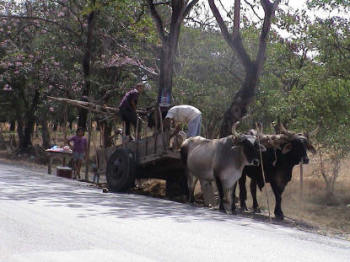
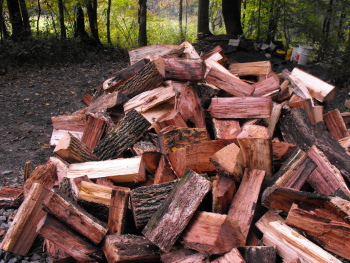 We bought a large truck load of firewood
recently due to the fact that we were too busy to cut any this summer,
and we've decided the extra time we get will be well worth the price.
We bought a large truck load of firewood
recently due to the fact that we were too busy to cut any this summer,
and we've decided the extra time we get will be well worth the price.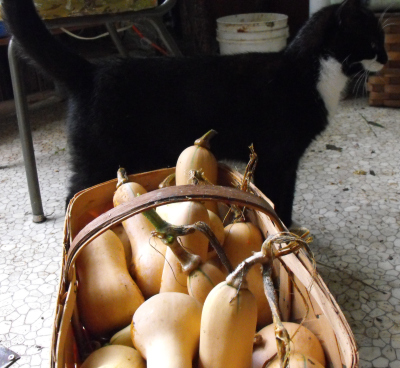
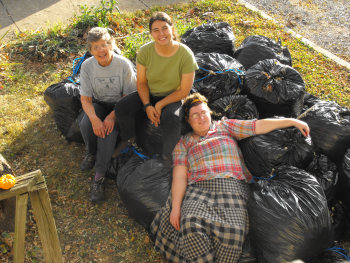 Guatemalan farmers harvest vast quantities of
fallen leaves (
Guatemalan farmers harvest vast quantities of
fallen leaves (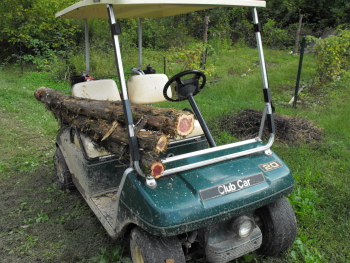 I was working on a small structure to protect
the firewood today. Stage 1 is to obtain 4 really long posts to work as
the frame. It will be like a mini pole barn without the walls.
I was working on a small structure to protect
the firewood today. Stage 1 is to obtain 4 really long posts to work as
the frame. It will be like a mini pole barn without the walls.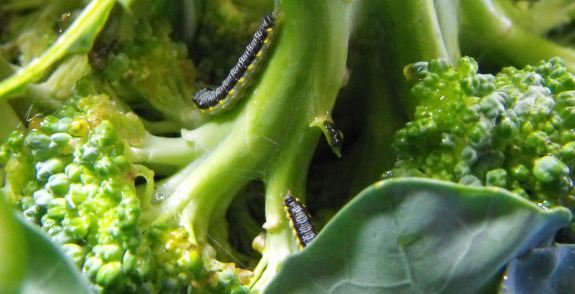
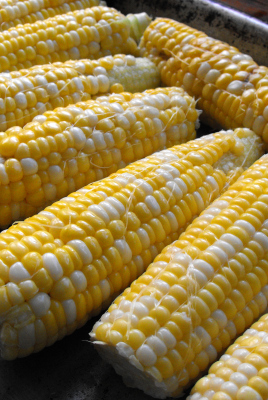 Still to be harvested this week are peas,
swiss chard, green beans, basil, and summer squash (ate our first
squash from the fall bed Monday!).
Still to be harvested this week are peas,
swiss chard, green beans, basil, and summer squash (ate our first
squash from the fall bed Monday!).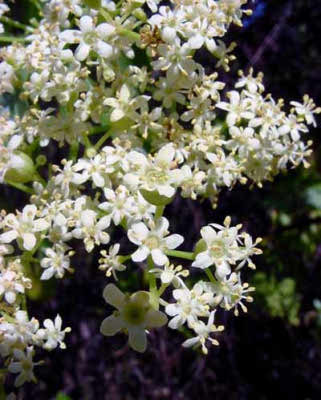
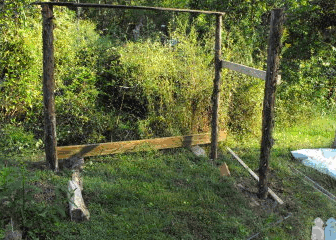
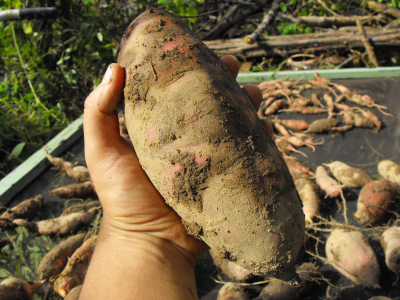 We want to plant twice as much garlic this
year as last year (more on that later), so I started eying the sweet
potato beds this week, wondering if they could be dug. A search
of the internet admonishes you to
We want to plant twice as much garlic this
year as last year (more on that later), so I started eying the sweet
potato beds this week, wondering if they could be dug. A search
of the internet admonishes you to 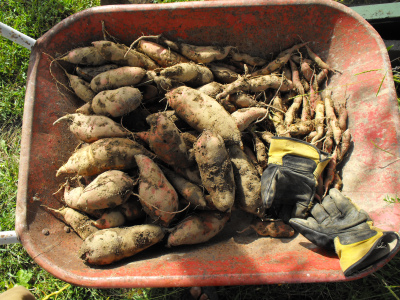 I dug up a few test plants and discovered a
good selection of large, medium, and small tubers. Presumably,
some of those useless tiny tubers would turn into useful medium tubers
if we let them wait another week or two. But I decided to harvest
anyway. After all, harvesting at this time last year let us
I dug up a few test plants and discovered a
good selection of large, medium, and small tubers. Presumably,
some of those useless tiny tubers would turn into useful medium tubers
if we let them wait another week or two. But I decided to harvest
anyway. After all, harvesting at this time last year let us 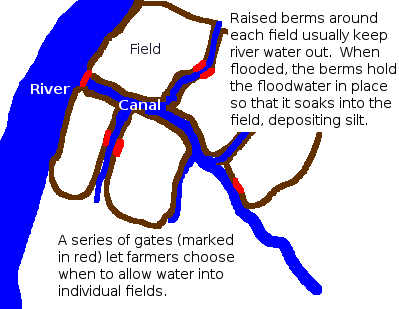 While Guatemala is full of methods of adding
plant matter to farm fields, it seems like Mexicans spend more energy
on harvesting sediment out of water. In the Tehuacan Valley of
southwest Mexico, elaborate systems of canals and dams are used to
apply just the right amount of top quality silt to fields.
While Guatemala is full of methods of adding
plant matter to farm fields, it seems like Mexicans spend more energy
on harvesting sediment out of water. In the Tehuacan Valley of
southwest Mexico, elaborate systems of canals and dams are used to
apply just the right amount of top quality silt to fields. 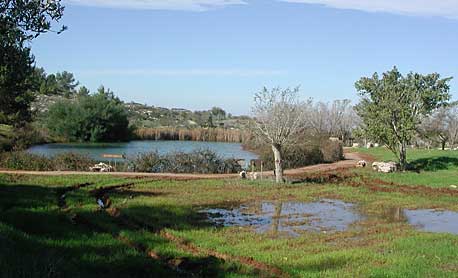
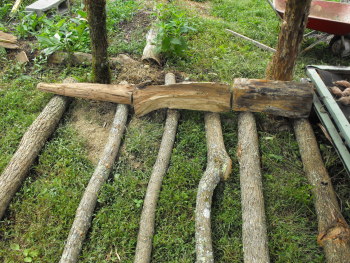
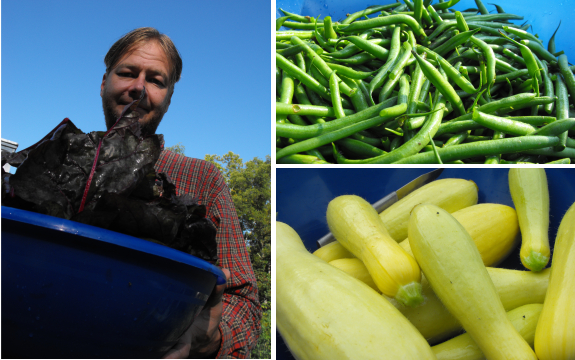
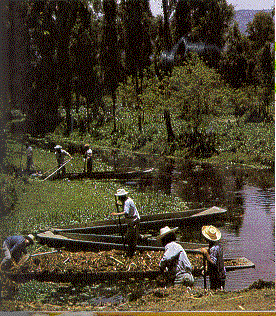
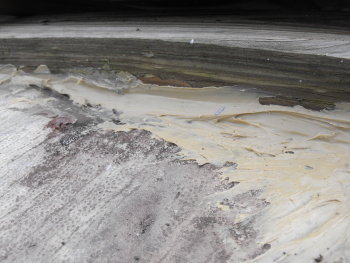
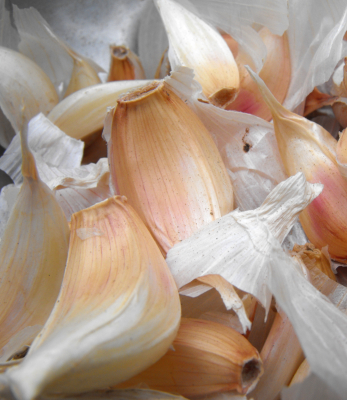 After two years of failed garlic harvests,
last year I spent $45 on a sampler pack of four types of garlic from
After two years of failed garlic harvests,
last year I spent $45 on a sampler pack of four types of garlic from 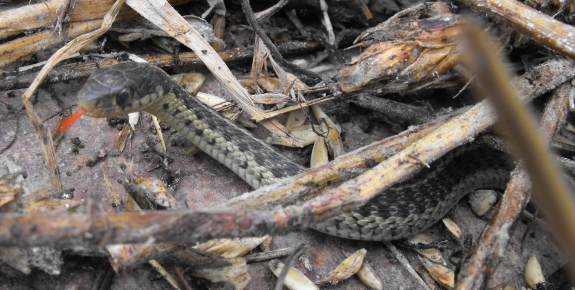
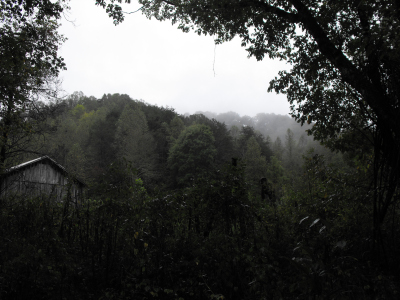 Mark's out saving the world this weekend, so I
thought my Mom might like to come over for the day and keep me
company. She drove up from town and arrived as the rain started
to pick up.
Mark's out saving the world this weekend, so I
thought my Mom might like to come over for the day and keep me
company. She drove up from town and arrived as the rain started
to pick up.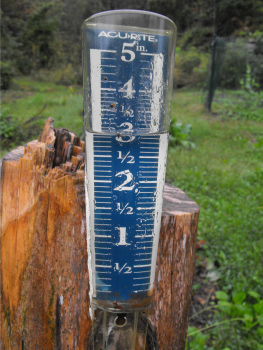 "Naw," I reassured her. "Unless we get
three inches in a day, we'll be fine."
"Naw," I reassured her. "Unless we get
three inches in a day, we'll be fine."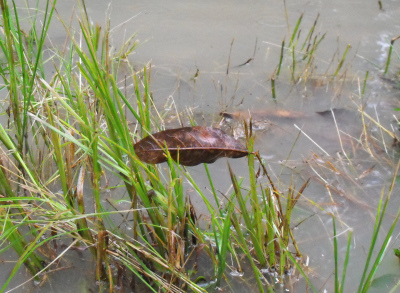 Lucy was in her element, galloping along the
water's edge. She jumped onto the footbridge, thrilled at the way
the creekwater was even with the boards. Bits of trash washing
down the creek lodged on the side of the bridge so that she barely had
to bend her head to grab them. A farm dog paradise!
Lucy was in her element, galloping along the
water's edge. She jumped onto the footbridge, thrilled at the way
the creekwater was even with the boards. Bits of trash washing
down the creek lodged on the side of the bridge so that she barely had
to bend her head to grab them. A farm dog paradise!

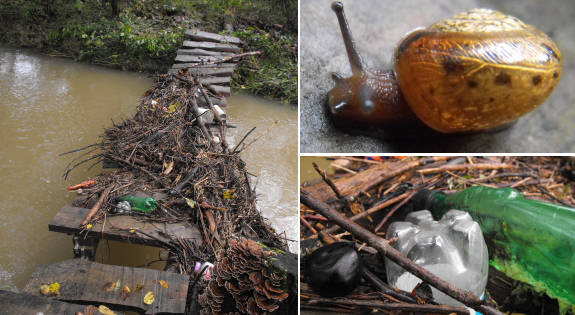
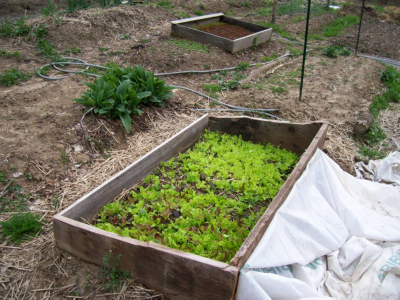


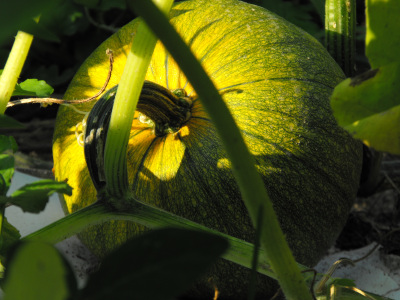
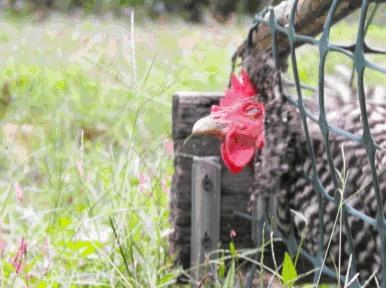
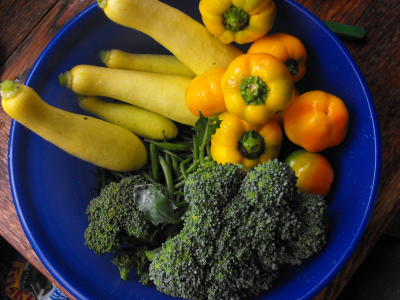 Nights have started dropping into the low 40s
this week --- time to get serious about freezing the last of the summer
crops.
Nights have started dropping into the low 40s
this week --- time to get serious about freezing the last of the summer
crops.